Volume 1, No. 1: The Worlds We Build + Old-Fashioned Apple Anise Cake
Hello and welcome! I am so excited to have you here. This newsletter is about to overflow with things I love, and I am delighted that you’ve decided to come along for the ride. I have so many amazing books and recipes to share with you! Let’s get to it.
Worldbuilding. It’s typically associated with fantasy and science fiction, but it’s certainly not confined to those genres. Every author, in their own way, builds a world with each book they write. We also build worlds all the time in our own lives. We build the world we’re living in (and the one we want to live in) with the stories we tell, with our actions, and in the ways we interact with others.
You could argue that all books are about worldbuilding. But these three explore the idea of worlds, and how we make them, in a thousand complicated and creative ways. Each of these authors is curious about what a world actually is—how a world gets made, who makes it and who it’s for, and what happens when it breaks or morphs or turns out to be something other than what we expected.
A note: Just after scheduling this newsletter, I learned about the shootings that happened last night in Georgia. Eight people were killed, six of whom were Asian women. This was yet another act of white supremacist violence and anti-Asian hate. I’m going to link to a few resources for addressing anti-Asian racism in this country at the bottom of this newsletter.
The Books
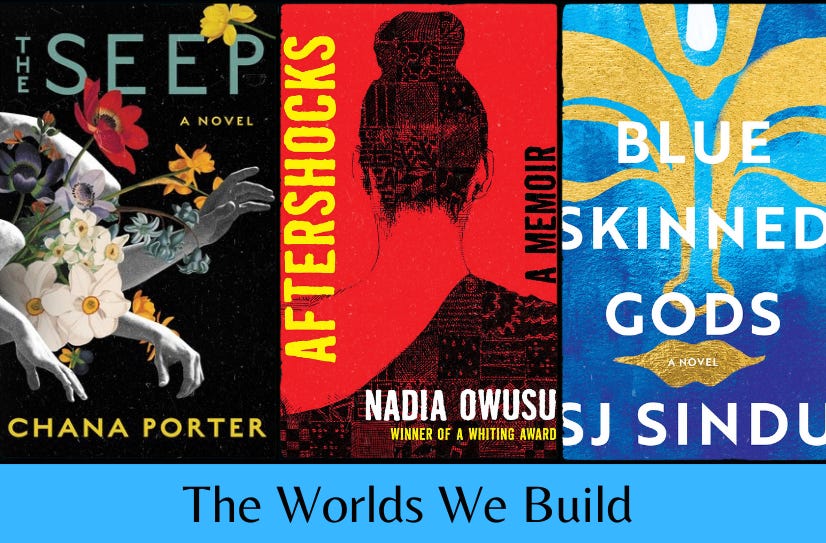
Backlist: The Seep by Chana Porter (Science Fiction, 2020)
Let me say first off that this book is beautifully weird, and not for everyone. It’s set in a future world that’s been forever altered by an alien invasion. This changed earth is hard to describe, and part of the pleasure of this novel is discovering all its strange beauty as you read, so I won’t go into detail. Basically, the aliens, known as The Seep, want everyone to live in blissful harmony. They’ve transformed earth into a utopia of endless possibilities.
Trina is a fifty-year-old trans woman who’s been living mostly-happily in this new reality with her wife, Deeba. But several years after The Seep’s invasion, Deeba leaves her. She wants to take advantage of the wild possibilities now open to her, and decides to become a baby again. Trina is left alone and grieving. The novel unfolds almost like a lucid dream, as Trina travels across the country, searching for a way forward in the aftermath of loss.
Trina is such a human character, so recognizably full of sadness and restlessness, traits that are especially poignant during her encounters with people who, high on The Seep, have no space for rage, despair, or grief. Everyone around her seems content with an easy existence, devoid of conflict. But Trina finds herself yearning for conflict, and becomes increasingly distraught and disconnected.
This is a messy, beautiful book about the consequences of utopia. I love how Porter uses The Seep to explore the idea of “the perfect world”. She’s curious about the kinds of worlds we tell ourselves we want, and the worlds we actually want. She’s curious about how it feels to navigate an intentionally crafted world. And about what happens when a world that’s supposed to offer you everything you could ever want starts feeling like a trap.
We talk so much about worldbuilding, both in literature and life. But this book left me thinking about the empty spaces. What gets left behind while we’re so focused on building something new? And what about the actual process of building something? Trina is a doctor, and her work post-Seep is very different from her life before. Healing with The Seep requires little skill. She’s grateful for the medical improvements The Seep makes possible, but she also misses the work. There’s so much familiar tension in that, and the book dives into it head first.
Additionally, this book is very queer, but there’s no homophobia or transphobia. Trina’s queer and trans identity is part of her, and affects how she experiences the world. Sometimes it’s centered, and sometimes it’s background. It’s also full of many beautifully written but very strange “WTF” moments. I was riveted by Porter’s imagination. This novel is full of humor, playfulness, and visceral scenes of odd encounters. It asks big questions. It’s also a distinctly fun, and slightly dizzying, reading experience.
Frontlist: Aftershocks by Nadia Owusu (Memoir)
It used to be that I rarely bought books, and when I did, it was only for one reason: I loved a library book I read so much that I had to own it. I buy more books now—it’s one small way I support authors I love. But this is a book I would have bought before. I listened to the audio (which is incredible), and as soon as I finished it, it went on my to-buy list. I knew I wasn’t done with it. I just want you to know how much I love this book before I start talking about it.
I want to be able to say “here is what this memoir is about” but I’ve been starting and deleting sentences for a few minutes now, and none of them seems quite right. This book is not easy to define. It feels like anything I say will reduce its complexity.
In broad strokes: Nadia Owusu was born in Tanzania to a Ghanaian father and Armenian-American mother. Her mother left when she was a child, and her father died when she was a teenager. She grew up in England, Ethiopia, Uganda, Ghana, and Italy, and moved to New York for college. She writes about all of these places and how they’ve shaped her. She writes about the geography of trauma and the topography of grief—and I mean those things both literally and metaphorically. This is a book about tangled webs of family, about placelessness and place-fullness, about the intersections of race, gender, language, and cultural identity, about the weight of silences, about mental illness, about how the telling of a story changes it. There. I made a sentence about what this book is about. Sort of.
There is so much world-making here. There’s the way Owusu builds the book itself, which is brilliant. It’s not linear or chronological, but moves fluidly through time and place. Reading it was like watching someone build a world out of many disparate parts. Owusu has one story to tell, but she does it by shattering that story into many pieces, looking at each one in exquisite detail, and then putting them back together again into something luminous.
Then there are the many worlds that Owusu inhabits, and the messiness of those worlds colliding, blurring, and dissolving into each other. I’m aware that I’m writing in abstracts here, and I’m doing it on purpose: I want you to hear Owusu tell you this story. I think, when you do, you will feel what I mean about worlds.
Throughout the book, she returns again and again to the idea of earthquakes, both actual earthquakes and metaphorical ones. The narrative is split into sections that explore the various kinds of shocks related to earthquakes—foreshocks, aftershocks. It’s an incredibly poignant lens through which to tell a story about what shatters worlds, and what remakes them.
I’ll leave you with this quote. In a scene early on in the book, Owusu’s elementary school teacher wants to know if she enjoyed an unexpected visit from her mother. When she starts to cry, the teacher asks her what’s wrong:
“How do I tell her about the trembling that leads to ripping, then to violent rupture; to whole lives and whole cities disintegrating; to piles and piles of ruble; to displacement and exile? How do I tell her that a day that begins with pancakes for breakfast can end in disaster; that, in an instant, an earthquake or a mother can arrive and change everything? How do I tell her that even when the earth stops shaking, cracks in the surface spread silently? Pent-up forces of danger and chaos can be unleashed at any time. I don’t know how to explain any of this, so I tell her I am afraid of the aftershocks.”
Upcoming: Blue-Skinned Gods by SJ Sindu (Fiction, Soho Press, 11/2)
This was the novel that inspired this theme. SJ Sindu masterfully builds a world for her readers to fall into, but the novel itself is also about the process of building worlds. I read this book back in January, and I’m still thinking about it. I can feel the shadow of it in other books I read, this idea of world-building and its consequences popping up in novel after novel. This, I think, is the mark of an exceptional book. It won’t let me go.
The story follows Kalki, a boy who grows up in an ashram in southern India. His father started and now runs the ashram, and Kalki has been raised as a god—the latest incarnation of the Hindu god Vishnu. Kalki has blue skin, a sign of his godhood, and villagers come to seek his blessing. As a child, he undergoes a series of trials to prove his divinity. He rarely leaves the ashram grounds. His entire existence is wound up in the story of his divinity. He knows no other life, no other way of being.
As Kalki grows up, and when he eventually leaves the ashram, the boundaries of this world blur, dissolve. What happens when your whole identity is built around a story you’ve been told? What happens when the world that has held you all your life shatters? How does that shattering change your understanding of the past? Is it possible to build a new world, all your own, out of the pieces of a broken one? These are the questions Sindu explores, with breathtaking nuance, care, and openness.
The novel is split into four parts, each narrated in the first-person by Kalki. Throughout the book, his relationships to the most important people in his life—his father, his mother, and his cousin Lakshman—morph and jump, always shapeshifting. The way that Sindu captures the complexities of these changing relationships is truly astonishing.
I read this book in two days, unable to focus on anything else. There’s a spellbinding quality to the prose. It's beautiful, though not flowery, but more than that, there’s a sureness in Sindu’s writing. It has heft and pull, momentum, like waves continually crashing on the shore. I knew immediately I was in the hands of a talented storyteller, one I trusted completely. At times it felt like the prose itself disappeared, and all that was left was the story underneath, vivid and alive.
I could go on at length, because this story is woven of layers upon layers. Religion, family, memory, history, friendship, sex, geography, brotherhood, delusion, appropriation: I could have picked any of these hefty themes and framed this review around it. All those themes aside, it’s a captivating, moving story with characters that feel startlingly real.
Blue-Skinned Gods is about the worlds we construct for ourselves and the worlds other people construct for us. It’s about how fragile those worlds can be, and how formidable. How hard it is to live inside them and how hard it is to break free of them. It’s about what happens when a story becomes a world, and what happens after the end of the world.
It’s out on November 2nd and you can pre-order it here. My apologies for raving about a book that’s not coming out for so long! It was supposed to come out in June, but in the time between when I read it and when I sat down to write this newsletter, it was pushed back. I promise it’s worth the wait.
The Bake
I adapted this recipe from one of my favorite baking books, Classic German Baking by Luisa Weiss. I love this book for a hundred different reasons, and one of them is the world that Weiss builds within its pages. She includes the stories behind many of the recipes—where they came from, how she came to them—and I love how this places recipes within a lineage, linking them to the past and future. I never baked with my grandmother, but these recipes almost make me feel as if I did.
In her introduction to this cake, Weiss writes: “it is firmly in the category of “grandmother cakes” that are baked at home with recipes that have been passed down from generation to generation.” That was enough to make me run to the kitchen. It’s also an example of the kind of world that she evokes with this cookbook, one that is homey and comforting and full of delicious smells.
My version is slightly different from the original, which doesn’t call for apples. If you want to try her version, I can’t recommend this cookbook enough. I have yet to make something from it that I haven’t loved.
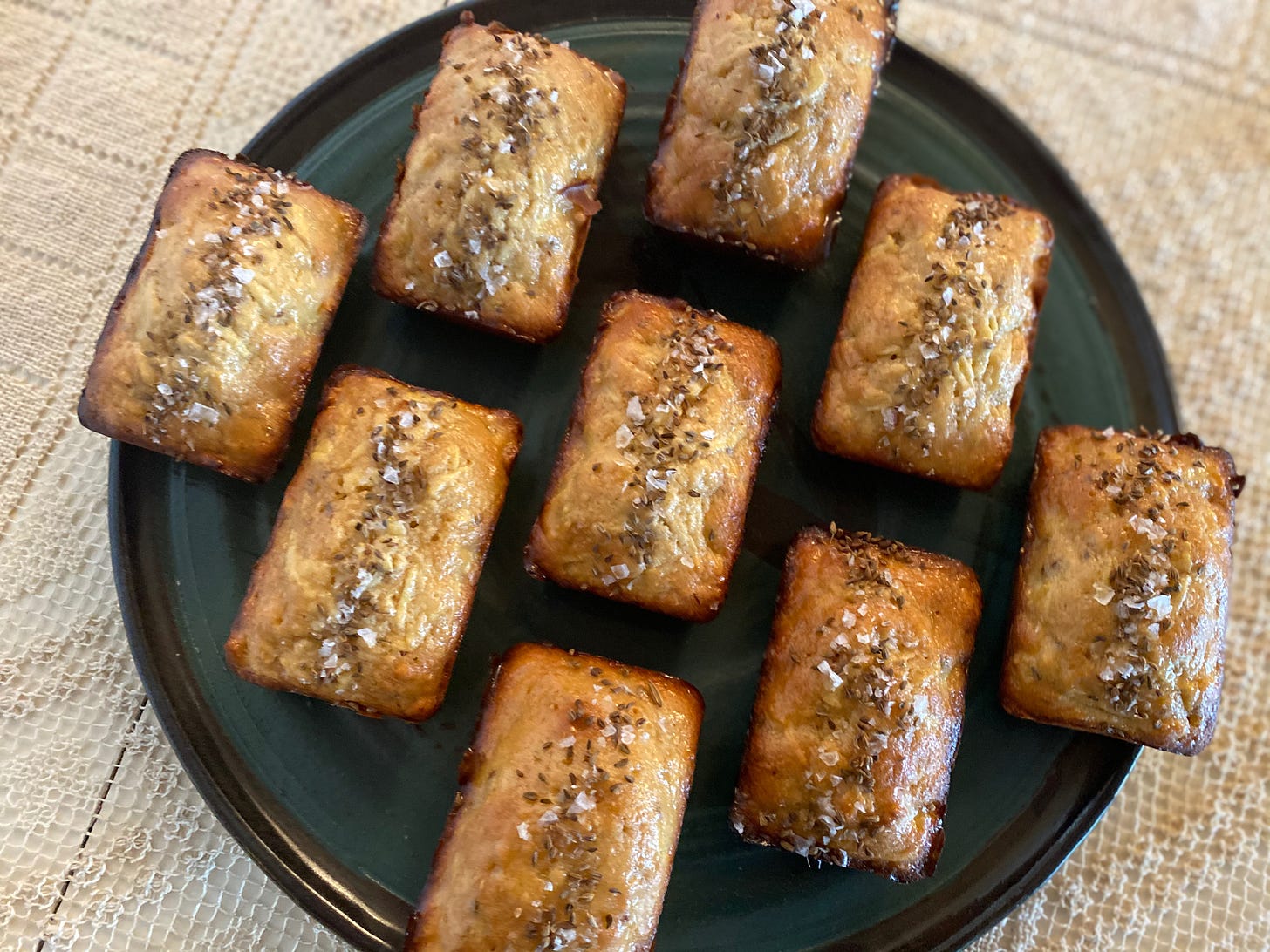
Old-Fashioned Apple Anise Sponge Cake
Makes 12 mini loaf cakes (or one 9x5 loaf cake)
This is not a moist cake. It’s airy, light, and a bit dry (it’s meant to be that way). It’s not too sweet, and the interplay between the apples and the anise is lovely. It’s the perfect teatime snack. It’s also easily altered. If you don’t like anise, use anything else: lavender, caraway seeds, a bit of cinnamon. Or leave out the spices and seeds altogether, and you’ll still have a delicious apple cake.
I love making these into mini cakes to give away, but if you don’t have mini loaf pans, a regular loaf pan will yield equally delicious results.
Ingredients
5 eggs
225 grams (1 1/4 cups) sugar (if you’ve never toasted your sugar, give it a go and prepare to be wowed!)
1/4 tsp salt
300 grams (2 1/3 cups + 1 Tbs) cake flour (subbing with AP is fine, or you can use this mix: 100 grams whole wheat pastry flour and 200 grams white pastry flour)
4 apples
2 tsp anise seeds, toasted
60 grams (1/2 cup) powdered sugar
Juice of 1/2 lemon
Preheat the oven to 350. Butter and lightly flour a 12-cavity mini loaf tin, or a 9x5 loaf pan.
Grate the apples (you can peel them or leave the skins on, your choice). Squeeze the juice out of the grated apples (like you’re making latkes!) and set it aside.
In the bowl of a stand mixer fitted with the whisk attachment, or using handheld beaters, whisk the eggs, salt, and sugar until pale, fluffy, and thick. The mixture should triple in volume.
Sift in the flour and stir gently with a wooden spoon or spatula. Don’t worry about mixing it all in yet. Add the grated apples and toasted anise seeds, and then fold it all together until everything is well combined. Be delicate with this! You don’t want to deflate the batter, which should be quite light.
Pour the batter into the prepared tins, filling them about 2/3 full. Bake for 22-25 minutes, until the tops are golden brown, and a tester inserted in the center comes out clean. (If you’re using a 9x5 loaf pan, bake for 55-60 minutes, rotating and covering the pan with aluminum foil after 30 minutes.)
While the cake is baking, make the glaze: whisk together the powdered sugar and lemon juice. Add the reserved apple juice a little bit at a time until it’s slightly thickened, but still pourable (like runny honey).
Let the cakes cool before unfolding them. Brush or drizzle the glaze on top. Sprinkle with flaky salt and additional anise seeds if you want. They’ll keep for a few days wrapped in plastic, and they’re good sliced and toasted even longer than that.
The Bowl & The Beat
The Bowl: Roasted Cauliflower, Sweet Potatoes, & Sausage
I make this dish at least once a week. It’s the thing I make when my body tells me I actually need to eat dinner, but I really don’t want to get off the couch. It’s so easy! The prep takes less than 15 minutes. It requires only a cutting board, a knife, and a baking sheet. You can alter it endlessly.
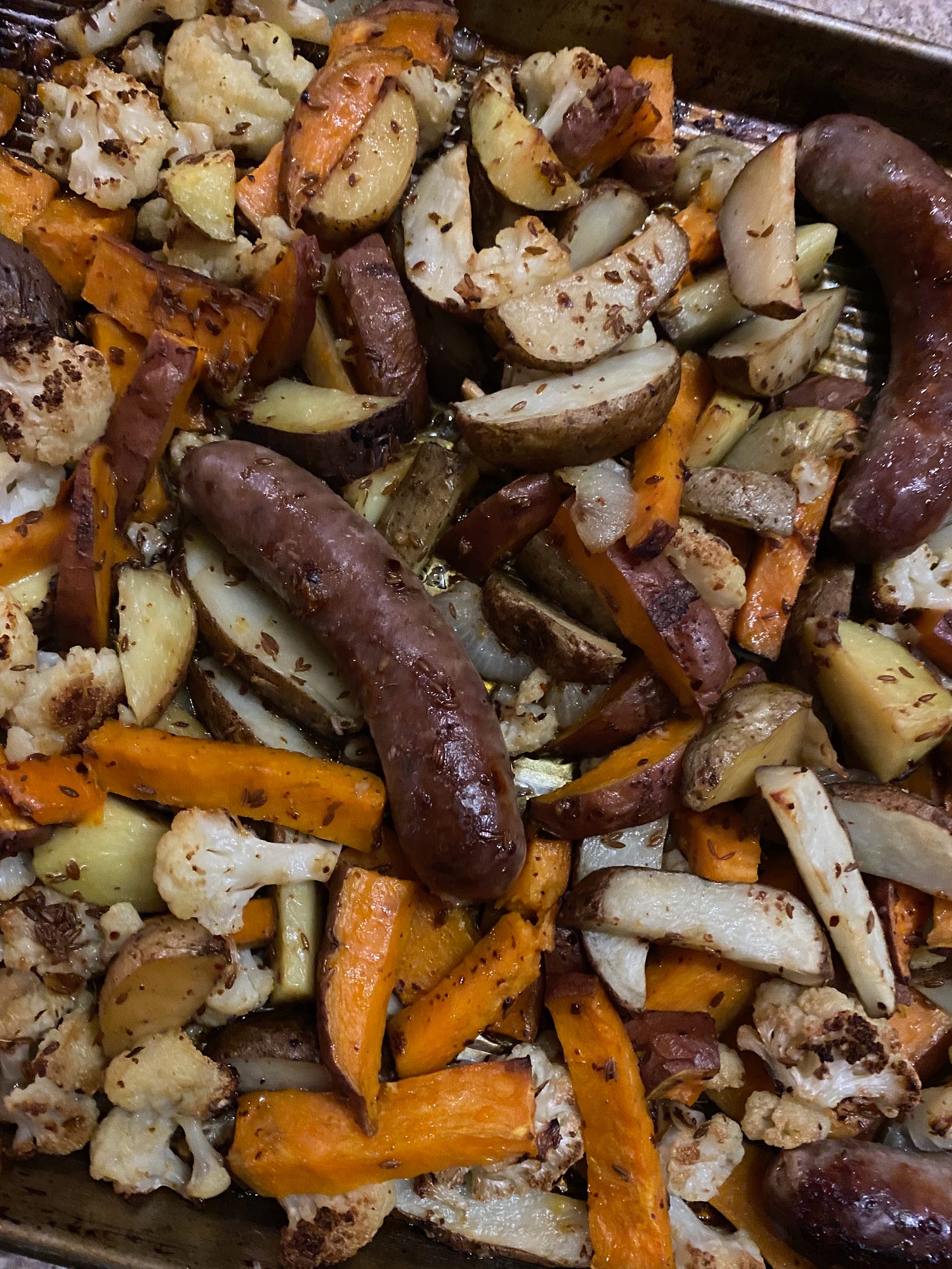
Turn your oven on to 450. Cut a head of cauliflower into florets and toss them on a rimmed baking sheet. Cut up a sweet potato or two—I like big wedges, you can do it however you want. Add that to the pan. Add a regular potato or three cut in wedges if you feel like it. If you have the energy, throw in an onion, quartered. If that feels daunting, don't bother. Drizzle the whole pan with olive oil, salt and pepper, and the spices of your choice (my go-to combo is cumin seed and Aleppo pepper). Mix with your hands until everything is nicely coated. Open a package of your favorite sausage and nestle the links between the veggies. If you don’t eat meat, forget about the sausage. Bake for 30-35 minutes, until the veggies are soft and crisp around the edges, and the sausage is cooked through and browned on the bottom.
If you don’t eat meat and want to add some protein to this meal, it’s great with a fried or hardboiled egg on top. If you have some greens or cooked grain sitting around, you can mix it with that. Sometimes I throw on some cheese. But mostly I just scoop it into a bowl as is and devour.
The Beat: Haben by Haben Girma
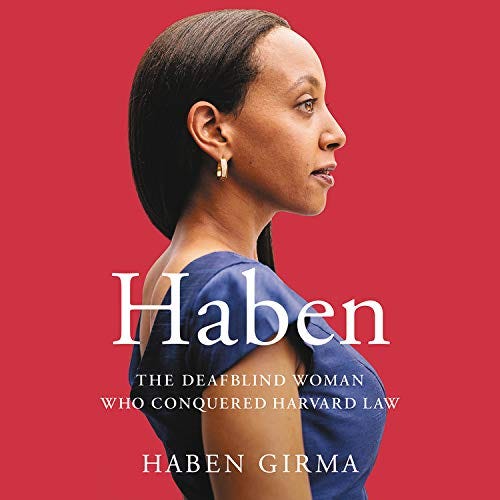
I’m only an hour and a half in, but so far I’m loving this. Haben Girma is a Deafblind lawyer and advocate, and the daughter of Eritrean and Ethiopian immigrants. I really like how the book is structured—she relates stories and experiences from different parts of her life, not strictly chronologically. So far, the narrative has moved from summers she spent at her grandmother’s home in Eritrea to her teenage years in Oakland, where she was often expected to navigate an ableist educational system on her own. I love listening to an author read their own memoir, and I’m really enjoying her narration.
She talks a lot about the hearing, sighted world, and what it’s like living in that world as a Deafblind person. It’s definitely got me thinking a lot about the many underlying assumptions and oppressions that exist in the worlds we build. As a hearing, sighted person, I don’t often think of the world I inhabit as the hearing, sighted world. I just think of it as the world. But there’s ablism embedded in that framework. And there’s so much possibility—for justice, for radical access and inclusion, for new ways of thinking, being, and feeling—when we push back against, and reject, that framework.
I’ve been following Haben Girma for a while on Instagram, and getting to hear more of her story has been a treat so far.
The Boost
First, a few resources for combating anti-Asian racism:
project 1907 has a comprehensive resources page
A few Instagram posts that highlight some ways to support the AAPI community right now (and always)
Second: When I originally conceived of this newsletter, I wasn’t going to tie anything into the theme expect the books. But that is obviously not how my brain works. So I’m closing out this issue with an invitation to support a collective that’s engaged in building the kind of world I want to live in.
Image: An Instagram post from SUSU commUNITY Farm. There is a lush green field in the foreground, with a red barn tucked into the treeline in the background. The sky is gray and cloudy, like a rainstorm is on the way. Text superimposed on the image reads: support our bipoc land and food sovereignty project @susuheals @susucommunity farm
Some backstory: I was a farmer for most of my adult life before now, and the rampant racism/classism/white supremacist bullshit in the “organic farming movement” is worth many more words than I am going to write here. In a (very tiny) nutshell, the privilege I have as a white woman from a wealthy background is a big part of what allowed me to successfully run a farm for seven years. So many people praised me for what I was doing, but nobody wanted to talk about why it was me doing it.
The “organic farming movement” is decidedly not white, but it is coded that way. Systemic racism in the food system creates barriers to access that keep many farmers of color from owning land/running farms. And migrant farmers, the people who grow so much of this country’s food, are often ignored altogether in conversations about food justice. (If you’re interested in learning more about any of this, the work of Chris Newman is a great place to start.)
In short, for a long time I was immersed in a world that has a lot of reckoning to do and is long overdue for massive change. I’m still a part of that world, and, since we all eat, so are you.
The folks at SUSU CommUNITY Farm are doing some serious worldbuilding work. From their website: “SUSU commUNITY Farm is a Afro Indigenous stewarded farm in Southern Vermont. We offer life affirming spaces for Black, Indigenous, People of color to THRIVE.” They’re currently raising funds to buy farmland on which to build their vision. They’ve also got a ton of great resources and ongoing programs. I encourage you to check out their work and donate if you can.
Finally, a bit of beauty to send you on your way: the ridge behind my house, where I walk my dog almost daily. This is from a few weeks ago, and most of the snow is gone now. I’m holding it in my heart right now because I’m not (quite) ready for spring.
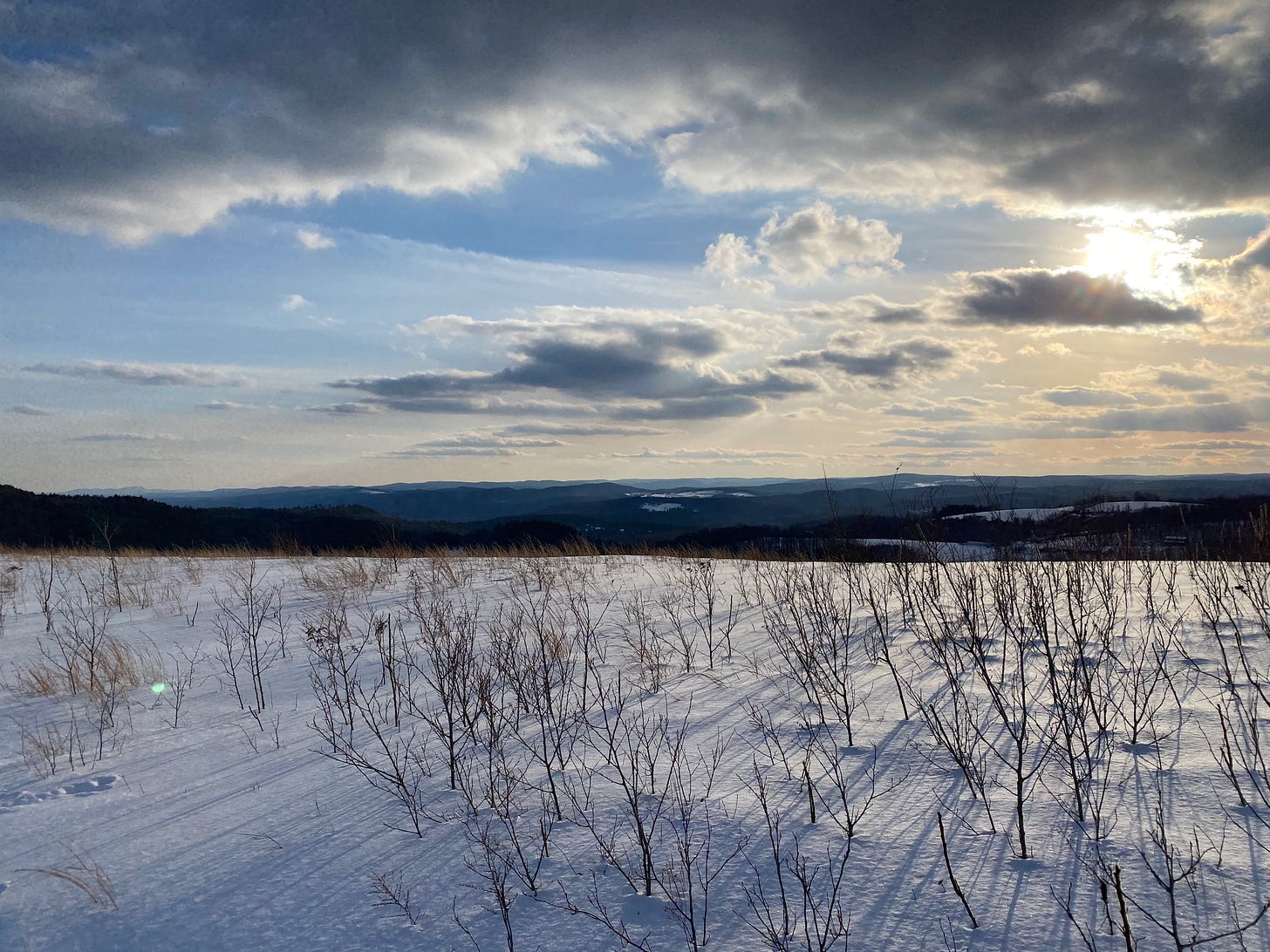
And that’s it until next week—see you then!




